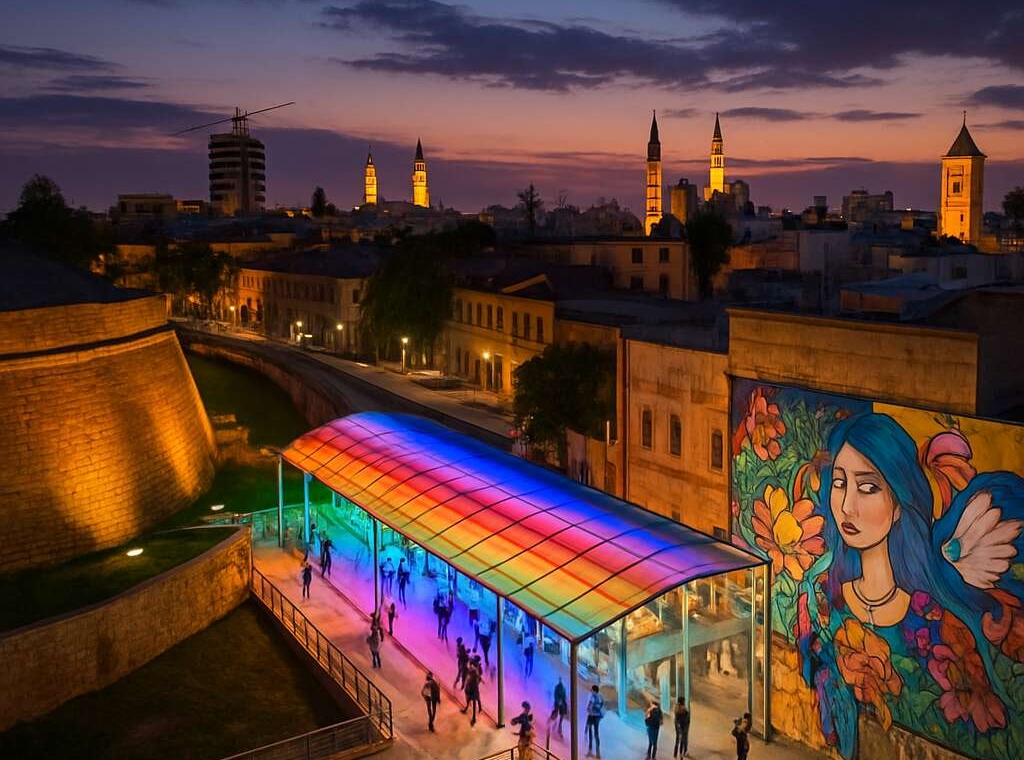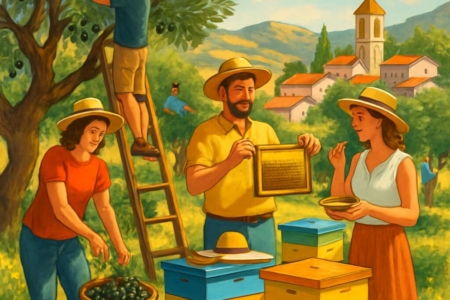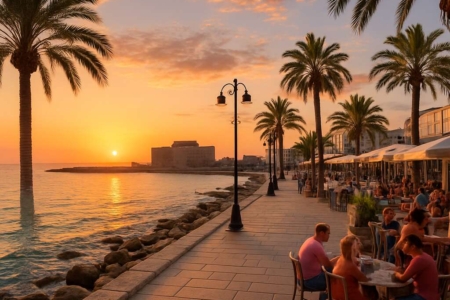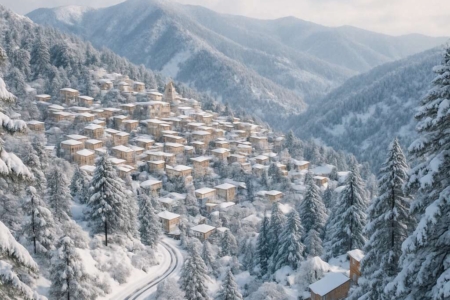Exploring the Historical Divide of Nicosia
The Historic Significance of Nicosia – Understanding Nicosia’s role in Cypriot history
Nicosia, famously known as the last divided capital in Europe, holds a story that is as complex as it is captivating. Its history is a tapestry woven with centuries of conquest, culture, and resilience. More than just a political border, the city embodies a profound cultural interest in divided Nicosia with cross-border art and history tours. These journeys reveal layers of history that many overlook—secretive Venetian walls, Ottoman relics, and modern murals that speak of hope and reconciliation.
Understanding Nicosia’s role in Cypriot history means recognising its significance as a crossroads of civilisation. It’s a city where East meets West, reflected in its architecture, art, and traditions. Exploring the historic divide offers visitors an immersive experience—walking through divided neighbourhoods, visiting museums that preserve memories of a fractured past, and witnessing the resilience of a city that continues to bridge its divides.
The Division of Nicosia: Causes and Consequences – Political and social factors behind the split
The division of Nicosia isn’t just a political quirk; it’s a dramatic saga etched into the very fabric of the city’s identity. Rooted in a complex cocktail of political and social factors, the split emerged from Cold War tensions, intercommunal strife, and international geopolitics. The consequences? A city split in two, with each side forging its own narrative—sometimes harmonious, often contentious—yet undeniably intertwined.
What makes the story even more intriguing is the layered history that visitors can explore today. The division has become a catalyst for cultural interest in divided Nicosia with cross-border art and history tours. These journeys peel back the layers of history, revealing hidden Venetian walls, Ottoman relics, and modern murals that serve as silent witnesses to hope and reconciliation. An understanding of these causes and consequences breathes new life into the city’s vibrant, if fractured, soul.
- Cold War politics
- Intercommunal conflict
- International negotiations
Each element has contributed to creating a city that is both a historical monument and a living canvas for cross-border cultural exchange. Exploring the causes and consequences of Nicosia’s division offers a captivating glimpse into how history shapes the present, making every tour an immersive dive into the city’s enduring resilience.
Landmarks that Tell a Story – Key sites representing the divided city
Standing at the crossroad of East and West, Nicosia’s landmarks whisper stories of a city torn between division and unity. Exploring the historical divide of Nicosia landmarks reveals a tapestry woven with layers of centuries-old relics and modern murals—each with a tale to tell. The Ledra Street checkpoint, once a symbol of separation, now serves as a vibrant passage where art and history intersect, embodying the city’s complex narrative.
For those with a keen eye for cultural nuance, the wall murals scattered across the Ledra Street and the buffer zone are silent yet eloquent witnesses to hopes of reconciliation. These artworks—created by cross-border artists—are more than mere decoration; they are a testament to resilience and a shared longing for unity. It’s this unique blend of history and creativity that fuels the growing cultural interest in divided Nicosia with cross-border art and history tours.
- The Venetian walls, still imposing after centuries of conflict, remind visitors of Nicosia’s strategic importance and turbulent past.
- Ottoman relics, tucked away in quiet corners, evoke stories of a bygone era that shaped the city’s identity.
- Modern murals, painted across the dividing lines, serve as vibrant symbols of hope and ongoing dialogue.
As you traverse these iconic sites, each step becomes an immersive journey into Nicosia’s layered history—an experience that showcases how physical divides can foster cultural dialogue and artistic expression. The city’s landmarks are not merely relics; they are living testament to a complex history that continues to inspire cross-border cooperation and cultural interest in divided Nicosia with cross-border art and history tours.
The Impact of Division on Local Communities – Cultural and social dynamics in Nicosia
The division of Nicosia isn’t just a political relic — it’s a living, breathing testament to the resilience and complex social fabric of its communities. The impact of division on local lives is profound; it shapes identities, influences relationships, and fuels a unique cultural interest in divided Nicosia with cross-border art and history tours. Despite the physical barriers, neighbourhoods buzz with stories of shared heritage and silent hopes for reunification.
Social dynamics in Nicosia are a fascinating mosaic, where generations have grown up side by side yet separated by a political chasm. Communities on either side of the border often find themselves caught between nostalgia and modern aspirations, creating a fertile ground for cultural exchange. Art, especially murals and installations, acts as a bridge—an unspoken dialogue that transcends politics and speaks directly to the human spirit.
As visitors wander through the city’s divided districts, they encounter more than relics and ruins; they witness a vibrant tapestry of hope and resilience. This is why the city’s layered history, intertwined with contemporary creativity, continues to draw keen explorers and curious locals alike. All of this fuels the growing cultural interest in divided Nicosia with cross-border art and history tours, revealing how even a city split in two can become a canvas for unity and renewal.
Cross-Border Art Initiatives in Nicosia
Public Art Projects Connecting the Sides – Murals and sculptures promoting unity
In a city where political borders once dictated the flow of everyday life, art has become the unexpected diplomat. Cross-border art initiatives in Nicosia are transforming the divided city into a vibrant canvas that promotes unity and dialogue. Murals and sculptures spanning the Green Line are not just eye-catching—they serve as visual protestations against separation, whispering tales of hope and coexistence to passersby.
These public art projects are more than mere aesthetics; they are powerful symbols of cultural interest in divided Nicosia with cross-border art and history tours. Visitors are often captivated by murals depicting shared heritage, or sculptures that challenge the lingering divisions. Such initiatives foster a sense of collective identity, bridging the political chasm with strokes of colour and form. The city’s walls have become open books, revealing stories of resilience, reconciliation, and the ongoing pursuit of peace.
Indeed, exploring Nicosia through these artistic expressions offers a unique perspective—one where creativity becomes a catalyst for change. As one walks through the city, it’s impossible not to notice the following:
- Murals portraying Cypriot unity, often featuring symbols like the olive branch or intertwined hands.
- Public sculptures that commemorate shared history, echoing the city’s complex past while inspiring hope for the future.
<li Art festivals that invite cross-border collaboration, showcasing the vibrant cultural interest in divided Nicosia with cross-border art and history tours.
Such initiatives reinforce that art, much like diplomacy, knows no borders—only boundaries waiting to be broken down, one brushstroke at a time.
Art Galleries and Exhibitions – Showcasing cross-border contemporary art
In Nicosia’s vibrant art scene, cross-border art initiatives are redefining the city’s cultural landscape. Art galleries and exhibitions dedicated to contemporary works from both sides of the Green Line serve as powerful symbols of unity. These curated showcases not only highlight the ingenuity of local artists but also foster a deeper cultural interest in divided Nicosia with cross-border art and history tours. Visitors have the rare opportunity to witness artworks that speak to shared experiences, resilience, and hope.
Many galleries actively participate in fostering dialogue through innovative exhibitions that challenge political boundaries. Temporary and permanent displays often include thought-provoking pieces such as mixed-media installations, evocative paintings, and sculptures rooted in Cypriot heritage. Such initiatives invite visitors to reflect on the city’s complex history while celebrating its creative future. This fusion of art and history awakens a profound sense of connection, inspiring dialogue that transcends division.
Artists Promoting Cultural Dialogue – Profiles of notable artists involved in peace initiatives
In the heart of Nicosia, a city torn by history but united by hope, a new wave of cultural dialogue is blossoming through cross-border art initiatives. Notable artists like Rüveyda Engin and Lefteris Arapakis are at the forefront, harnessing their creativity to bridge divides and foster understanding. Their works often reflect shared narratives of resilience, connecting people beyond political boundaries.
These artists actively promote cultural interest in divided Nicosia with cross-border art and history tours, revealing the city’s layered story through immersive experiences. Their projects serve as powerful symbols of reconciliation, inviting visitors to witness the beauty that emerges when art becomes a language of peace. Often, their pieces include evocative murals and sculptures that challenge perceptions and inspire dialogue, nurturing a collective memory rooted in hope and unity.
Community Engagement Through Art – Workshops and collaborative projects
In the heart of Nicosia, where history’s shadows still linger, a captivating movement is unfolding—one that transforms division into dialogue through cross-border art initiatives. These projects are more than mere creative expressions; they serve as vital catalysts in fostering cultural interest in divided Nicosia with cross-border art and history tours. Visitors are invited into a world where murals, sculptures, and collaborative installations tell stories of resilience, hope, and reconciliation.
Community engagement through art is at the core of these efforts. Workshops and collaborative projects connect artists, locals, and visitors alike, igniting a shared sense of purpose. For example, artists often organise series of participatory art workshops that challenge perceptions and cultivate understanding between the two sides of the city. Such initiatives not only promote cultural interest in divided Nicosia with cross-border art and history tours but also nurture a collective memory rooted in unity.
- Joint mural projects that span the Green Line, transforming walls into symbols of peace.
- Interactive history tours that incorporate local stories and artistic expressions.
- Community-led sculptures that reflect shared aspirations for reconciliation.
Through these immersive experiences, the city’s layered history is brought into focus, revealing the complex tapestry that binds Nicosia’s past and present. As art becomes a language of peace, these cross-border initiatives subtly rewrite the narrative of division—transforming it into a testament to resilience and hope.
Historical Tours in Divided Nicosia
Walking Tours of Key Historical Sites – Visting Ledra Street and surrounding areas
Divided Nicosia is a city where history whispers from every corner. Walking through Ledra Street offers more than just shopping — it’s a journey into the heart of Cypriot resilience. The cross-border art and history tours reveal stories of separation and hope, making them a compelling choice for anyone interested in cultural interest in divided Nicosia with cross-border art and history tours.
On a guided tour, visitors can explore key historical sites that define Nicosia’s layered identity. The narrow streets are lined with murals and sculptures that speak of unity, while ancient landmarks remind us of a city divided yet deeply connected. The walk often includes visits to:
- Ledra Street’s vibrant marketplace and its surrounding neighbourhoods
- The legendary buffer zone, a symbol of division
- Historical mosques, churches, and remnants of the city’s diverse past
With each step, the tour offers an immersive experience into Nicosia’s complex history, making it an essential part of understanding the city’s ongoing journey towards reconciliation. This blend of history and art creates a captivating narrative for those seeking cultural interest in divided Nicosia with cross-border art and history tours.
Guided Cross-Border Museum Visits – Exploring Ethnographic and archaeological museums
Divided Nicosia holds a treasure trove of stories waiting to be uncovered. Guided cross-border museum visits reveal layers of ethnographic and archaeological history that showcase the city’s rich and complex past. These tours provide a rare chance to explore exhibits and artefacts that highlight Nicosia’s diverse cultural tapestry, spanning ancient relics to modern narratives.
Visitors often explore key institutions such as the Cyprus Museum and the Leventis Municipal Museum, both offering insights into the city’s layered identity. These sites serve as vital gateways into understanding how history shapes the present. Engaging with local curators and historians, travellers gain a deeper appreciation for the cultural interest in divided Nicosia with cross-border art and history tours.
During the tour, participants can also delve into ethnographic displays that tell stories of community resilience, migration, and coexistence. It’s a chance to see how art and history intersect, fostering dialogue between the two sides of the city. Such cross-border museum visits are essential for anyone eager to grasp the enduring spirit of Nicosia’s divided yet unified cultural landscape.
Pathways of Peace: The Opening of Ledra Street – Significance of crossing points
Few moments in history are as charged with meaning as the opening of Ledra Street’s crossing point in 2008. This event symbolised hope, resilience, and the fragile bridge between divided communities. For those exploring the cultural interest in divided Nicosia with cross-border art and history tours, this site is a pilgrimage point, rich with stories that transcend political boundaries.
Walking along Ledra Street, visitors can grasp the profound significance of these crossing points. They are not only gateways for commerce and daily life but also symbols of reconciliation—a testament to the city’s enduring spirit. The pathway of peace that the street represents breathes life into the city’s complex narrative of division and unity.
- Understanding the historical context behind the crossing points enriches the experience.
- Witnessing the subtle graffiti and murals here reveals narratives of hope and resilience.
- Engaging with local guides uncovers stories of how these routes shaped community identities over decades.
Cross-border tours in Nicosia often include visits to the iconic Ledra Street, where the atmosphere is thick with history and anticipation. These pathways of peace are living symbols of reconciliation, offering a rare glimpse into a city where division has become a canvas for hope, art, and cultural dialogue. Such moments deepen the cultural interest in divided Nicosia with cross-border art and history tours, making every step a journey into the heart of its layered past and hopeful future.
Personal Stories from Local Guides – Firsthand accounts of life in a divided city
Walking through the labyrinthine streets of divided Nicosia reveals a tapestry woven with stories of resilience, hope, and unyielding spirit. Personal stories from local guides breathe life into this historical mosaic, offering intimate glimpses into everyday life in a city split by political discord. These guides, themselves witnesses to decades of division, recount tales of perseverance that transform the city’s landmarks into living archives of collective memory.
Many guides describe their childhood memories of crossing borders at Ledra Street, where hope flickered like a fragile flame amidst the shadows of division. Their narratives illuminate the impact of political splits on social dynamics and cultural identity, enriching the experience for visitors engaged in cross-border art and history tours. As one guide passionately notes, “Every mural, every monument here tells a story of unity struggling to prevail over division.”
To deepen the understanding of Nicosia’s layered history, visitors often explore
- community-led art projects
- local workshops fostering dialogue
that embody the city’s ongoing pursuit of reconciliation. These personal accounts and grassroots initiatives underscore how the city’s divided landscape has become a powerful canvas for cultural dialogue, inspiring visitors to see Nicosia not just as a city split in two, but as a symbol of hope and resilience—an enduring beacon for those invested in the cultural interest in divided Nicosia with cross-border art and history tours.
Cultural and Educational Experiences
Workshops and Cultural Events – Participating in local craft and history workshops
Amidst the shadowed streets and crumbling facades of divided Nicosia, a mysterious allure beckons those seeking a deeper understanding of its layered history. The city’s cultural interest in divided Nicosia with cross-border art and history tours offers a rare glimpse into the resilience of human spirit and artistic expression. Participating in local craft and history workshops reveals the intricate tapestries woven through generations—each stitch whispering stories of hope and despair.
Engaging with these workshops often immerses visitors in traditional Cypriot crafts, from pottery to embroidery, fostering a tangible connection to the city’s multifaceted past. Additionally, cultural events—ranging from live performances to thematic exhibitions—serve as vibrant portals into the collective memory of a nation split by politics yet united through art. These experiences forge bridges across the divide, illuminating Nicosia’s enduring quest for unity.
For those eager to delve even deeper, a carefully curated list of activities awaits:
- Participating in cross-border art projects that challenge boundaries and inspire dialogue.
- Attending specialised workshops on Cypriot history, led by local artisans and historians.
- Engaging in collaborative art installations that symbolise peace and reconciliation.
Such initiatives not only enrich the cultural interest in divided Nicosia but also transform the city into a living canvas—where every brushstroke and craft piece echoes a narrative of hope amid division.
Language and Heritage Programs – Learning about Cypriot culture from both communities
In the heart of a city divided, where history and hope collide, learning about Cypriot culture from both communities offers a profound, transformative experience. Cross-border art and history tours reveal the layered tapestry of Nicosia’s heritage, exposing visitors to a mosaic of traditions, stories, and shared memories. These programmes foster genuine understanding, transcending political borders to highlight common roots and aspirations.
Language and heritage programmes serve as vital bridges—allowing participants to immerse themselves in local dialects, folk tales, and culinary customs. Engaging with local artisans and historians often involves
- interactive storytelling
- traditional cooking classes
- language exchanges
that deepen cultural insight and forge authentic connections. These initiatives illuminate the resilience of Cypriot identity, making every encounter a testament to unity amid division.
Intercultural Exchanges – Fostering understanding through joint projects
In a city where history’s echoes are still palpable, the power of intercultural exchanges in divided Nicosia reveals a profound narrative of resilience and hope. Cultural interest in divided Nicosia with cross-border art and history tours fosters a unique environment where communities come together through shared creativity and dialogue. These initiatives extend beyond sightseeing—they create spaces for meaningful collaboration and mutual understanding.
Participating in joint projects, local artists and historians engage in activities that bridge divides and build bridges across cultural boundaries. Through workshops, collaborative murals, and storytelling sessions, visitors witness firsthand how art becomes a vessel for peace and reconciliation. These initiatives often include:
- Cross-border art collaborations that transform blank walls into vibrant symbols of unity
- Shared archaeological excavations that uncover stories from both sides of the divide
- Community-led history projects that highlight common roots and divergent paths
Such projects not only deepen cultural interest in divided Nicosia with cross-border art and history tours but also foster genuine understanding. Every brushstroke and each shared narrative serve as a testament to the enduring human spirit, illustrating how collective efforts can shape a more hopeful future amid division. These exchanges exemplify how art and history become catalysts for peace, turning the city’s scars into symbols of reconciliation and shared identity.
Cookery Tours and Food Tastings – Experiencing Cypriot cuisine reflecting diverse traditions
In a city where history’s scars are etched into every corner, experiencing Cypriot cuisine offers a deliciously authentic way to bridge divides. Food is a universal language, and in divided Nicosia, it becomes a symbol of unity and shared tradition. Culinary tours lead visitors through bustling markets and cosy tavernas, revealing the rich tapestry of local flavours rooted in diverse cultural influences.
Participants can indulge in traditional meze, savour sweet baklava, or sample spicy souvlaki—each bite telling stories of intertwined heritage and resilience. Notably, these cookery tours and food tastings foster cultural interest in divided Nicosia with cross-border art and history tours, allowing visitors to immerse themselves in the city’s vibrant culinary landscape while appreciating its complex history.
Often, tours incorporate cultural exchanges that highlight the city’s gastronomic diversity, offering insights into how food unites rather than divides. From shared recipes passed down through generations to lively communal dinners, every flavour serves as a reminder that even amidst division, the love of good food can create common ground and foster meaningful dialogue.
Planning Your Cross-Border Nicosia Tour
Best Times to Visit – Seasonal considerations for cultural tours
Timing your visit to divided Nicosia can profoundly influence your experience of its layered history and vibrant cultural scene. Interestingly, the city’s seasonal rhythms offer distinct opportunities for immersive cross-border art and history tours, revealing different facets of its complex narrative. Spring (March to May) and early autumn (September to November) are particularly ideal, as the weather is mild, inviting exploration of outdoor murals, historical sites, and bustling street life without the sweltering heat or winter chill.
During these peak seasons, the city’s cultural interest in divided Nicosia with cross-border art and history tours flourishes. The vibrant spring blooms often mirror the blossoming of collaborative art projects and intercultural exchanges that connect both sides of the city. Conversely, winter tourism can be more subdued but offers a contemplative atmosphere, perfect for delving into museums and engaging with local guides’ personal stories. Whether wandering Ledra Street or attending specialised workshops, timing your visit can enrich your understanding of Nicosia’s ongoing journey of reconciliation and cultural dialogue.
Guided vs. Self-Guided Tours – Pros and cons
Choosing between guided and self-guided tours when exploring the cultural interest in divided Nicosia with cross-border art and history tours can significantly shape your experience. Guided tours offer the advantage of expert insights, allowing you to delve deeper into the city’s layered history and the symbolism behind its iconic murals and landmarks. These tours often include exclusive access to sites that might otherwise be overlooked, enriching your understanding of Nicosia’s complex narrative.
On the other hand, self-guided tours provide flexibility and an intimate pace, perfect for travellers who prefer to immerse themselves in the city’s vibrant street art or explore at their own rhythm. For those seeking a personalised journey, using maps and local app guides can reveal hidden gems and foster spontaneous interactions with the city’s diverse communities.
- Customisable itineraries
- Freedom to linger or move swiftly
While self-guided options may lack the depth of expert commentary, they can foster a more personal connection to the city’s ongoing story of reconciliation and cultural dialogue.
Practical Tips for Crossing Borders – Visa requirements, safety, and local customs
Crossing the border in Nicosia isn’t just a matter of stepping from one side to another; it’s an immersion into a layered narrative of resilience and reconciliation. For those keen on exploring the cultural interest in divided Nicosia with cross-border art and history tours, understanding practicalities is crucial. Visa requirements can vary depending on your nationality, so meticulous planning ensures a seamless experience—don’t forget to verify whether your passport needs additional documentation for border crossings.
Safety remains a top priority. While the crossing points are generally secure, staying informed about local customs and current travel advisories enhances your confidence. It’s wise to carry some cash in the local currency, as not all establishments accept cards, especially in less touristy areas. Engaging with local guides can enrich your journey, offering insights that deepen your understanding of Nicosia’s complex history and ongoing cultural dialogue.
For a smooth crossing experience, consider these practical tips:
- Check the latest visa and border regulations before your trip.
- Keep your identification documents easily accessible.
- Respect local customs and social norms, especially at sensitive sites.
Remember, each border crossing in Nicosia is a step into a city that embodies hope through its vibrant murals, poignant museums, and bustling community spaces. Embrace the moment—every detail matters in uncovering the rich tapestry of the divided city’s cultural interest in cross-border art and history tours.
Where to Stay and How to Get Around – Accommodations near key sites, transportation options
In the shadowed heart of Cyprus lies a city fractured by history, yet alive with an undeniable cultural pulse. Planning your cross-border Nicosia tour demands more than mere navigation; it requires a careful orchestration of place and purpose. Accommodation near key sites offers a refuge amid the labyrinth of murals, museums, and bustling alleyways — where every stone whispers stories of resilience. From boutique guesthouses to historic hotels, the proximity to landmarks like Ledra Street or the Leventis Museum ensures you’re immersed in the city’s layered history.
Getting around Nicosia reveals a city that balances old-world charm with modern vibrancy. Public transportation, such as buses ferrying across the border, weaves a tapestry of connectivity, while walking remains an intimate way to absorb the city’s subtleties. For those seeking freedom in exploration, rental bikes or organised guided tours provide a seamless experience of the divided city’s enigmatic allure. Whether you choose to traverse the border on foot or by vehicle, each journey deepens your understanding of the profound cultural interest in divided Nicosia with cross-border art and history tours.





